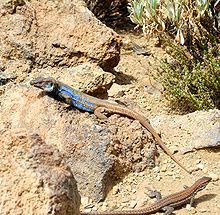Gallotia
| Gallotia | |
|---|---|
 |
|
|
Tenerife Lizard (Gallotia galloti galloti) male (top) and female |
|
| Scientific classification | |
| Kingdom: | Animalia |
| Phylum: | Chordata |
| Class: | Reptilia |
| Order: | Squamata |
| Family: | Lacertidae |
| Subfamily: | Gallotiinae |
| Genus: |
Gallotia Boulenger, 1916 |
| Species | |
The genus Gallotia are the lacertids (wall lizards) of the Canary Islands. This genus consists of a group that has been evolving there ever since the first islands emerged from the sea over 20 million years ago. The endemic species and subspecies of this group have a number of characteristics that make them quite special within their family (Lacertidae); their only close relatives are the sandrunner lizards (Psammodromus) of the western Mediterranean region. Gallotia are characteristic for eating significant quantities of plants, and for several lineages having evolved insular gigantism.
This genus can be broadly divided into two groups - lineages originating from the colonization of the earliest Canary Islands of Lanzarote, Fuerteventura and Gran Canaria, probably between 10-20 million years ago, and a lineage that colonised the younger western islands probably less than 10 million years. ago (Cox et al., 2010). Both lineages contain large and small species.
MtDNA analyses indicate that Lanzarote and Fuerteventura were colonized first and this led to the small body-sized G.atlantica which is present today (Cox et al., 2010). Gran Canaria was the next island to have been colonized from Lanzarote/Fuerteventura, giving rise to the large body-sized species, G. stehlini (Cox et al., 2010). Finally, the clade that colonized the younger western islands was likely to have originated from Lanzarote/Fuerteventura. This western island clade diverged into two groups, all of which colonized Tenerife, La Palma, La Gomera and El Hierro, leading to 1) a medium-bodied (e.g., G. caesaris from El Hierro) and 2) a large bodied "giant" species (e.g., G. simonyi from El Hierro) on each of these islands (note that G. intermedia from Tenerife belongs to the "giant" group, but present-day individuals are not that large). The giant species now exist, at best, in small relict populations, while G. auritae may be extinct on La Palma. (These patterns are based on analyses of mtDNA alone, and may be refined in the future after analyses of the nuclear genome). It is possible that remains of extinct giant forms will eventually be discovered on Fuerteventura & Lanzarote.
...
Wikipedia
